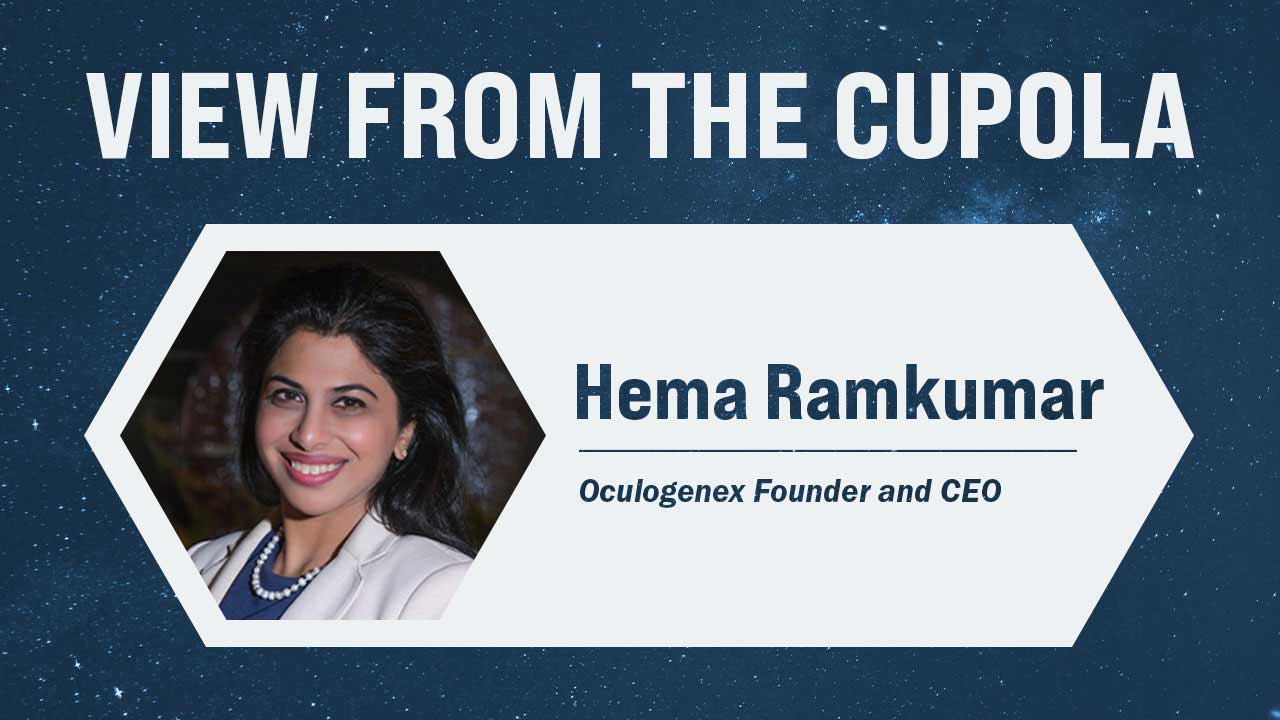View From the Cupola: Hema Ramkumar

March 25, 2025 • By Hema Ramkumar, Founder and CEO of Oculogenex
At age 11, I was crazy enough to declare my intent to cure blindness. Throughout my teens and twenties, I spent every minute after school, on weekends, and late nights in research laboratories learning how the eye works and how vision fails. This foundation shaped my future as a retinal surgeon. Over the last 10 years, I have found pride and joy in restoring my patients’ eyesight in Southern California.
However, the leading cause of blindness in the U.S., dry age-related macular degeneration (AMD), remains daunting. We have no answers for patients with this debilitating disease, which leads to the loss of central vision. It’s often the elephant in the room at eye clinics, the thing we can’t fix—a disease that strips millions of their independence and ability to see the results of their life’s endeavors, the faces of their loved ones, and the legacy they aim to leave.
The relentless progression of the disease and the absence of effective treatments deeply frustrates me. Witnessing the daily suffering of my patients often leaves me exhausted and nearly defeated. This feeling of defeat compelled me to return to my scientific roots in search of meaningful, long-term solutions where seemingly none existed.
Fueled by this determination, I established Oculogenex in 2020. We created a comprehensive facility that included a research and development lab, a retinal imaging center, and a surgical lab, all aimed at fighting retinal degeneration. Our team developed mouse models and tissue cultures that demonstrated our promising gene therapy could halt disease progression. Maybe it wasn’t so crazy to think I could cure blindness after all.
Despite our progress, the limitations of our laboratory models on Earth prevented us from fully understanding our therapy’s regenerative properties. To find a better model of macular degeneration, we looked for an environment that is as hostile to the eye as macular degeneration is to those with the disease. To explore this potential, we leveraged the International Space Station (ISSInternational Space Station)—a unique environment that degrades the macula in a way that mimics macular degeneration. Our participation in the MassChallenge accelerator program led to a Technology in Space PrizeA prize that provides grant funding for business startups participating in the MassChallenge startup accelerator program to conduct innovative research and technology development utilizing the ISS National Lab. The prize is funded by the Center for the Advancement of Science in Space, which manages the ISS National Lab, and Boeing. in 2021, which affirmed our innovative approach and facilitated sponsorship by the ISS National Laboratory®. Collaborations with our Implementation Partner(Abbreviation: IP) Commercial companies that work with the ISS National Lab to provide services related to payload development, including the translation of ground-based science to a space-based platform. Leidos, NASA’s Kennedy Space Center, and others further enabled us to send genetically treated mice to space onboard SpaceX’s 30th Commercial Resupply Services (CRS) mission.
As you read through this issue’s cover story, you will see how our journey into space-based research with the ISS National Lab opened a revolutionary new path to treating macular degeneration. Our findings have validated our gene therapy’s potential to address this challenging disease and paved the way for clinical trials that could change lives. This endeavor goes beyond scientific achievement—it’s a collective step toward a future where the world’s leading cause of blindness is nothing more than a memory.
This issue also highlights ISS National Lab-sponsored research on Janus base nanomaterials (JBN), which could provide innovative new treatments for osteoarthritis and cancer. By taking JBN production to space, where gravity-driven forces are eliminated, researchers from the University of Connecticut and Eascra Biotech significantly increased the quality of their nanomaterials. Manufacturing JBNs in microgravityThe condition of perceived weightlessness created when an object is in free fall, for example when an object is in orbital motion. Microgravity alters many observable phenomena within the physical and life sciences, allowing scientists to study things in ways not possible on Earth. The International Space Station provides access to a persistent microgravity environment. could lead to better treatment outcomes for patients on Earth, and the team is partnering with Axiom Space to one day make this a reality.
The third feature in this issue tells the story of Emory University researchers utilizing space-based research to accelerate the development of cell replacement therapies to treat heart failure. Through a series of ISS National Lab-sponsored investigations, the team uncovered insights that could be applied on Earth to more efficiently generate the large numbers of heart muscle cells needed for cell replacement therapies. The findings could also enable scientists to develop cells that are more resilient post-transplantation, potentially improving outcomes for over 6.5 million Americans suffering from heart failure.
This research, conducted in the unique space environment, reflects our broader goal: to harness space-based science for the benefit of Earth. Each story in this issue expands on how these extraordinary efforts could soon offer real hope to millions. As I reflect on our progress and the potential of our discoveries, I’m filled with gratitude for every scientist, partner, and supporter joining us on this path. Together, we are turning once-distant dreams into tangible realities, proving that innovation and collaboration can overcome even the most formidable challenges.